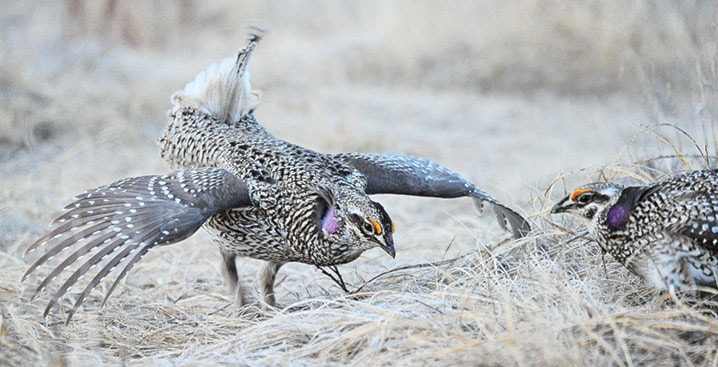For untold millennia, a remarkable spring ritual has played out across the grasslands, parklands and woodland edges of North America.
Spurred by some ancient and mysterious cue, male sharp-tailed grouse congregate each year in late March on their ancestral dancing grounds to compete for the privilege of passing on their genes. Males defends a small territory within a large lek (also called an arena), with each vying for the best piece of real estate and thus the right to mate. Most leks in Alberta have 10-20 males and the average lek size is 5 to 20 square metres .
We were fortunate to have the opportunity to witness this spring rite of passage a few weeks ago at CFB Wainwright, on a tour arranged by Laurence Hoover with the Wainwright Wildlife Society. We were treated to a magnificent performance
The dance of the sharp-tailed grouse is both comical and extravagant: with their tail feathers erect and white rear feathers fully fluffed, the males lower their wings to the ground, stretch out their necks and vigorously stomp around in small circles. Their pounding feet produce a tinny rattling sound which is accompanied by weird vocalizations as well as booms emanating from purple neck air sacks. Bright yellow eyebrows held erect add a garish touch to the theatrics.
The males dance alone or while facing others at the edges of their respective territories. They alternate between dancing frenetically and freezing motionless. Individuals will sometimes rush each other and there is the occasional aerial combat. Sometimes two or three individuals will squat in front of each other to engage in glaring matches (with the odd peck thrown in for good measure). If a predator happens by, the entire lek is temporarily abandoned.
The birds usually dance for a few hours at dawn and then head off to feed for the rest of the day. They dance most vigorously in the spring but also reassemble on the leks in the fall to reestablish territories and dominance hierarchies.
Female sharpies appear at the leks during mid to late April and wander through the maze of displaying males. The males, each desperate to become a chosen suitor, dance even more frenetically in her presence. The hen finally selects and then mates with the most impressive male before wandering off in search of a suitable nesting site. Like all lek species, the females form no pair bond with the males and the males have no part in looking after the young. The dominant males get to mate with several females while the subordinates dance in vain.
If you would like to view this amazing natural spectacle, check out http://wainwrightdistrict.org/wildlife.
NOTE: Ellis Bird Farm is now open for the season. Check out www.ellisbirdfarm.ca for details.
Myrna Pearman is the biologist/site services manager at Ellis Bird Farm. She can be reached at mpearman@ellisbirdfarm.ca.
